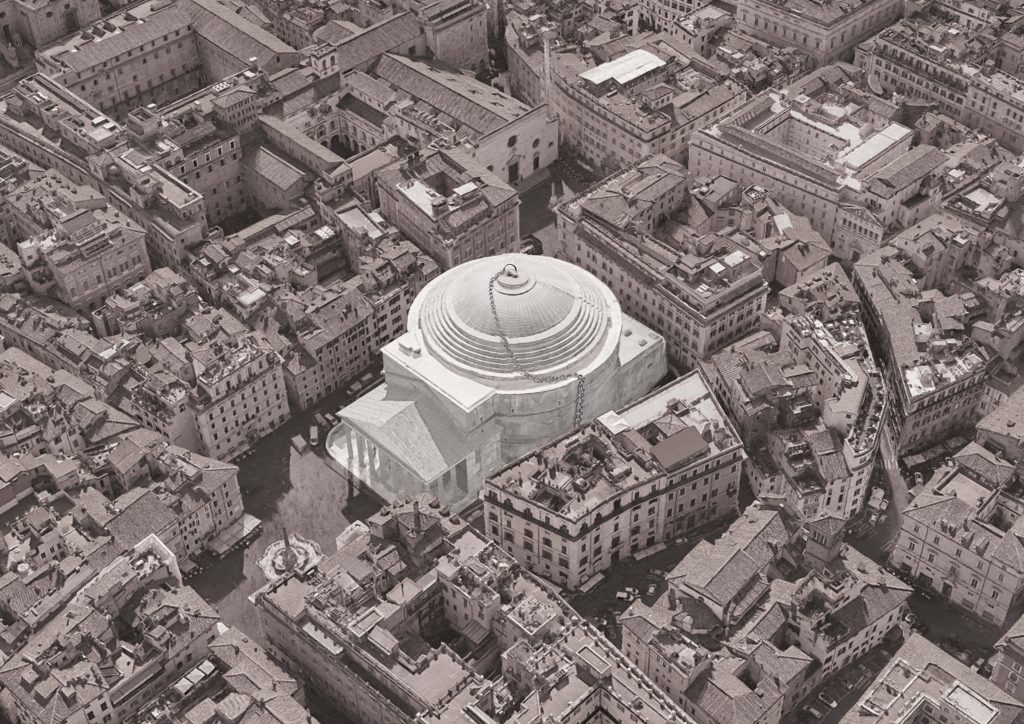Students receive recognition in the CCA Interuniversity Charrette
February 23, 2024
Fourth-year students Conor Nicell and Max Godfrey have received Special Mention in the 2024 Canadian Centre for Architecture (CCA) Interuniversity Charrette for a theoretical installation that shows the Pantheon in Rome capped by a giant bath plug.
“Connor and Max have demonstrated a strong and critical design strategy throughout the semester,” said Instructor Jay Lim. “Their submission for the CCA Charrette is a great example of their ability to be both critical and playful with their award-winning solution.”

See the winners here: https://www.cca.qc.ca/charrette/2024/winners.html
This year’s edition of the charrette, titled Beyond the Roof, was based on the idea that spaces that exist on the world’s rooftops are underutilized and remain uninvested. It invited participants to choose the roof of an existing building and propose an intervention that may take advantage of, or challenge, the roof as a fifth facade, and call into question the notions of property, habitat, use, and legislation.
Nicell and Godfrey’s proposal, titled Pantheon, sprang from discussions about the tendency of modern skyscrapers to cast shadows upon buildings below them and how shadow could ruin a famous roof.
“Plugging the oculus of the Pantheon with a giant rubber bath plug serves to sever this ancient masterpiece’s unique relationship with the sky,” they explain.
“Through leaving the hole in the roof open, Emperor Hadrian effectively made the sky a part of his roof. Now that this has been taken away, the great chamber below is plunged into darkness, and the building loses much of its appeal. The concept serves as an extreme example of how shadow can ruin an architectural masterpiece.”
The jury evaluated 48 proposals by teams composed of undergraduate and graduate students, as well as recent graduates from the Université de Montréal, McGill University, Concordia University, UQAM, Carleton University, University of Ottawa, University of Toronto, Université Laval, University of Waterloo, University of British Columbia, and Ontario College of Art and Design University.
Participating teams had four days to develop a proposal in response to the theme.
The entire fourth-year studio at the Azrieli School of Architecture & Urbanism, led by Associate Professor Inderbir Riar, Professor Greg Andonian, Adjunct Professor Eric Archambault, and Instructor Jay Lim, took part.
Lim’s group includes Nicell and Godfrey. “It was an opportunity to put Carleton’s best against other schools,” he said.
The studio, 25:8 City_Urban Trialities, is exploring architectural programming that can make a city active 25 hours: 8 days a week. The project is in LeBreton Flats. The students will also enter their projects in the National Capital Commission national student competition, National Urban Design Challenge 2024.
The jury members for the CCA contest were:
Nicolay Boyadjiev, an architect and creative director based between Copenhagen, Sofia and Los Angeles;
Daniel Zamarbide, an architect recognized both in Switzerland and internationally for his experience in the design and construction of research-oriented architecture;
Alena Prochazka, who holds a PhD in Urban Studies and has led an international research team about urban roofscapes through the prism of energy and ecosystems.
The annual Interuniversity Charrette, initiated in 1995 by the CCA in Montreal, Que., is open to students and recent graduates in architecture, landscape architecture, urbanism, environmental design, urban design, industrial design, and graphic design.
This year’s edition was organized by the CCA in partnership with the Université du Québec à Montréal, the Université de Montréal, and McGill University.
The Pantheon
Conor Nicell and Max Godfrey
All buildings have a relationship with the sky above them, even if this relationship is as simple as a basic roof to separate the two. This was a more lighthearted approach that was intended to be controversial, subtle, and even a little bit humorous.
The concept of plugging the oculus of the Pantheon with a giant bath plug arose from two discussions at the start of the competition. The first was about the tendency of modern skyscrapers to cast ever-growing shadows upon the, often, older buildings below them. These shadows interrupt the careful details of the pre-existing urban environment, and risk interrupting delicate moments in the design.
The second discussion took place after this theme was chosen and was centered around what the most controversial way to ruin a famous roof would be. The idea of shadow was central to this discussion, and so the Pantheon was chosen to convey our point due to the delicate and sophisticated nature of the oculus, and the timelessness of the building itself. The aim was to spur discussion, raise some eyebrows, and hopefully create a few laughs.
Intended as a theoretical temporary art installation, plugging the oculus of the Pantheon with a giant rubber bath plug serves to sever this ancient masterpiece’s unique relationship with the sky. Through leaving the hole in the roof open, Emperor Hadrian effectively made the sky a part of his roof. Now that this has been taken away, the great chamber below is plunged into darkness, and the building loses much of its appeal. While there were several valid interpretations of this bold decision, the concept serves as an extreme example of how shadow can ruin an architectural masterpiece.